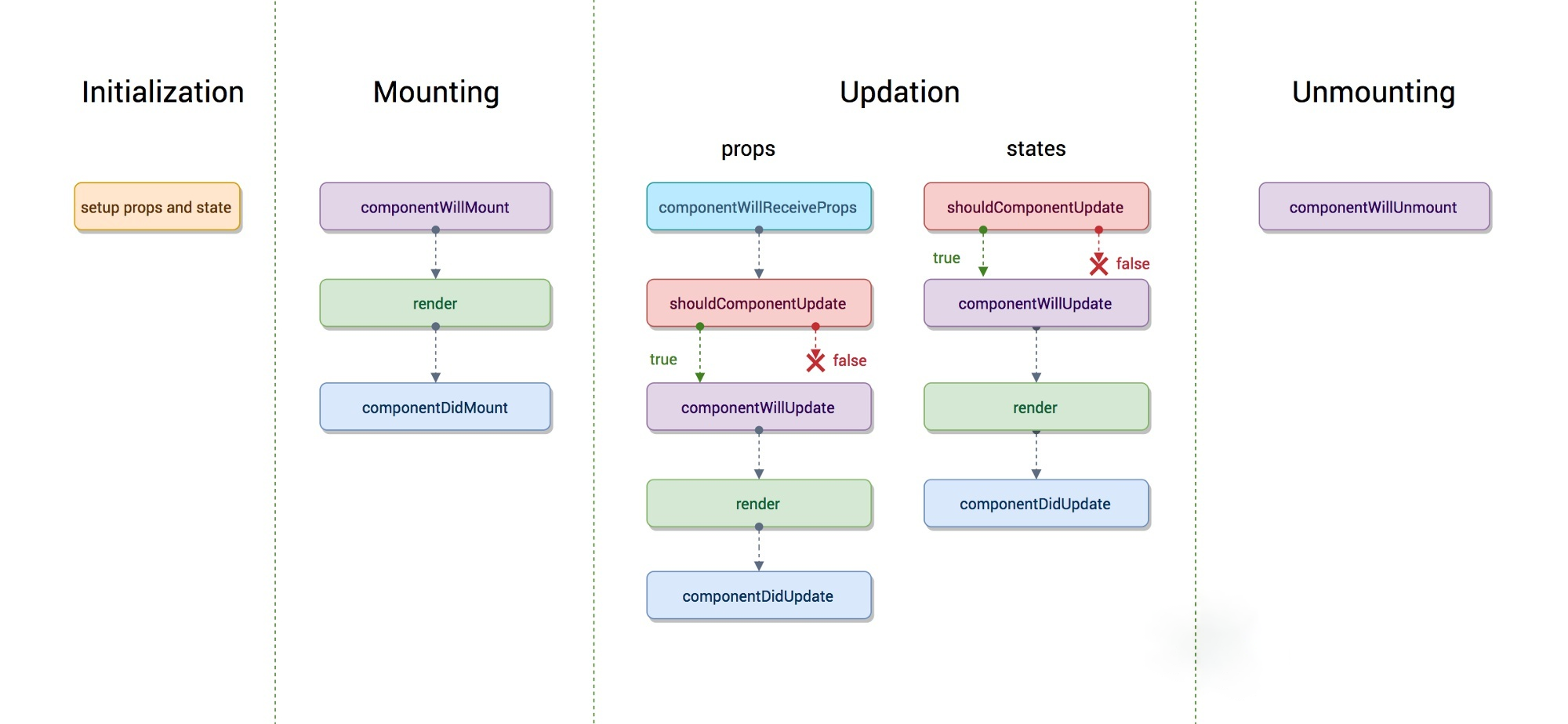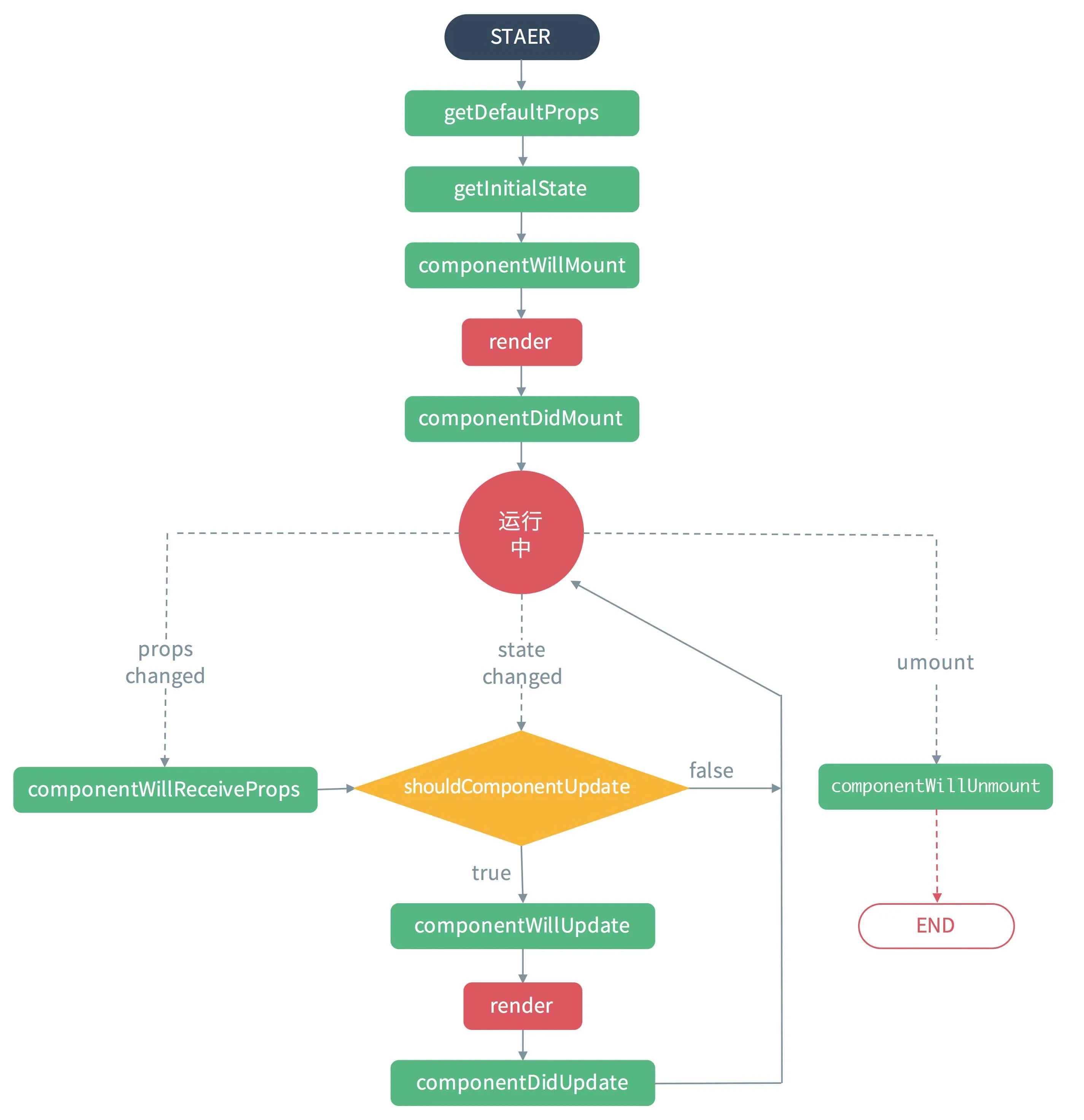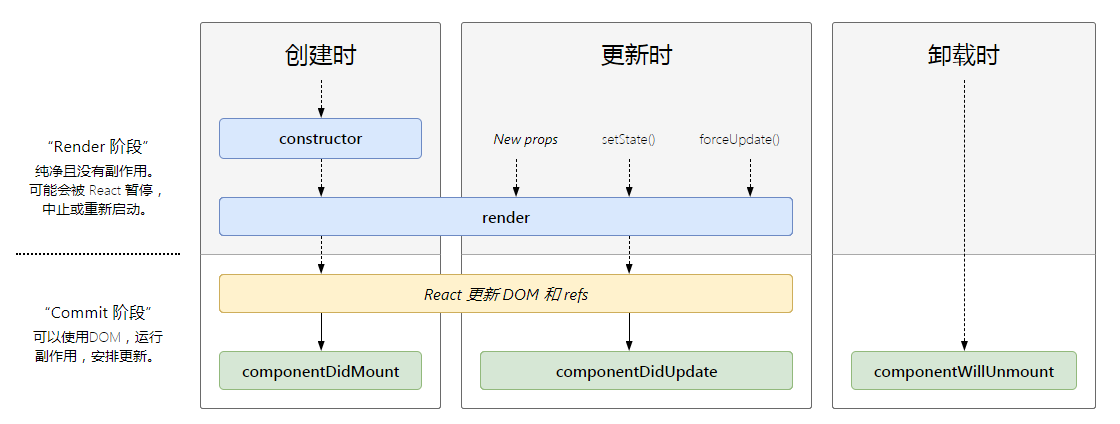# React 入门必学【下】
# React 生命周期
每个软件都有从开始创建到运行到最终销毁的一段路程,这可以说成是软件的生命周期
组件本质是状态机,输入确定,输出一定的确定。状态发生转化时会触发不同的钩子函数,从而让开发者做出响应,可以用事件的思路理解状态。
初始化----》运行中----》销毁
# React16.3.0 之前生命周期:
16 版本之前的 react 组件的生命周期相信大家已经很熟悉。16 版本的 react 对组件的生命周期函数进行了一些修改,下面进行详细说明。
如图:


创建期:
1.constructor(props, context)
2.componentWillMount()
3.render()
4.componentDidMount()
2
3
4
5
6
7
运行时: props 发生变化时
1.componentWillReceiveProps(nextProps, nextContext)
2.shouldComponentUpdate(nextProps, nextState, nextContext)
3.componentWillUpdate(nextProps, nextState, nextContext)
4.render
5.componentDidUpdate(prevProps, prevState, snapshot)
2
3
4
5
6
7
8
9
10
11
12
state 发生变化时
1.shouldComponentUpdate(nextProps, nextState, nextContext)
2.componentWillUpdate(nextProps, nextState, nextContext)
3.render
4.componentDidUpdate(prevProps, prevState, snapshot)
2
3
4
5
6
7
8
9
卸载时:
componentWillUnmount()
# React16.3.0 之后的生命周期


创建期:
1.constructor(props, context)
2.static getDerivedStateFromProps(props, status)
3.render()
4.componentDidMount()
或者如下生命周期:
1.constructor(props, context)
2.componentWillMount() / UNSAFE_componentWillMount()
3.render()
4.componentDidMount()
2
3
4
5
6
7
8
9
10
11
12
13
14
15
16
17
注意: getDerivedStateFromProps/getSnapshotBeforeUpdate 和 componentWillMount/componentWillReceiveProps/componentWillUpdate 如果同时存在,React 会在控制台给出警告信息,且仅执行 getDerivedStateFromProps/getSnapshotBeforeUpdate 【React@16.7.0】
运行时:
props 发生变化时
1.static getDerivedStateFromProps(props, status)
2.shouldComponentUpdate(nextProps, nextState, nextContext)
3.render
4.getSnapshotBeforeUpdate(prevProps, prevState)
5.componentDidUpdate(prevProps, prevState, snapshot)
或者如下生命周期:
1.componentWillReceiveProps(nextProps, nextContext)/
2.UNSAFE_componentWillReceiveProps
3.shouldComponentUpdate(nextProps, nextState, nextContext)
4.componentWillUpdate(nextProps, nextState, nextContext)
5.render
6.componentDidUpdate(prevProps, prevState, snapshot)
2
3
4
5
6
7
8
9
10
11
12
13
14
15
16
17
18
19
20
21
22
23
state 发生变化时
1.static getDerivedStateFromProps(props, status)
2.shouldComponentUpdate(nextProps, nextState, nextContext)
3.render
4.getSnapshotBeforeUpdate(prevProps, prevState)
5.componentDidUpdate(prevProps, prevState, snapshot)
或者如下生命周期:
1.shouldComponentUpdate(nextProps, nextState, nextContext)
2.componentWillUpdate(nextProps, nextState, nextContext)/
3.UNSAFE_componentWillUpdate
4.render
5.componentDidUpdate(prevProps, prevState, snapshot)
2
3
4
5
6
7
8
9
10
11
12
13
14
15
16
17
18
19
20
21
销毁时
componentWillUnmount()
# 生命周期详解
1.constructor(props, context)
constructor 生命周期,如不需要,可缺省。通常会在 constructor 方法中初始化 state 和绑定事件处理程序。 但是,如果写了 constructor,那么必须在其中调用 super(props);否则可能会引起报错
如:
class Base extends Component {
constructor(props) {
super(); //应该为 super(props);
}
state = {
name: this.props.name
}
//....code
}
2
3
4
5
6
7
8
9
抛出异常: Uncaught TypeError: Cannot read property 'name' of undefined.
同样,如果定义了 context,在 state 中需要使用 this.context 去获取 context 上的内容,则需要 super(props, context);
不过,如果你缺省 constructor,那么在 state 中,可以放心的使用 this.props 或者是 this.context,不会引起报错。
class Base extends Component {
state = {
name: this.props.name,
color: this.context.color
}
//....code
}
2
3
4
5
6
7
初始化的 state 同样可以在 constructor 中定义。如果需要给方法绑定 this,那么统一在 constructor 中进行。
2.static getDerivedStateFromProps(props, state)
当组件的 state 需要根据 props 来改变的时候可调用此方法。这个方法是在 render() 前会被执行,每次触发 render 前,都会触发此方法。
该方法有两个参数 props 和 state; 返回值为 state 对象, 不需要返回整体 state,把需要改变的 state 返回即可。如果不需要,可以返回 null.
class Base extends Component {
state = {
age: 20
}
static getDerivedStateFromProps(props, state) {
return {
age: 50
}
}
render() {
// 50
return (
<div>{this.state.age}</div>
)
}
}
2
3
4
5
6
7
8
9
10
11
12
13
14
15
16
这个方法允许组件基于 props 的变更来更新其内部状态,以这种方式获得的组件状态被称为派生状态。应该谨慎使用派生状态,可能会引入潜在的错误
3.render
React 组件中必须要提供的方法。当 state 或者 props 任一数据有更新时都会执行。
render() 是一个纯函数,因此,不要在其中执行 setState 诸如此类的操作。render 必须有一个返回值,返回的数据类型可以有:
null、String、Number、Array、Boolean。
React elements
Fragment
Portal
注意不要在 render 中调用 setState
4.componentDidMount
componentDidMount()方法是在组件加载完后立即执行,也就是当该组件相关的 dom 节点插入到 dom 树中时。该方法在组件生命中只执行一次。
一般情况,我们会在这里 setState(),或者进行接口请求,设置订阅等。
class Base extends Component {
state = {
age: 20
}
componentDidMount() {
this.fetchDate();
}
render() {
return (
<div>{this.state.age}</div>
)
}
//other code
}
2
3
4
5
6
7
8
9
10
11
12
13
14
5.shouldComponentUpdate(nextProps, nextState, nextContext)
在渲染新的 props 或 state 前,shouldComponentUpdate 被调用,默认返回 true。forceUpdate()时不会调用此方法。
如果 shouldComponentUpdate()返回 false,那么 getSnapshotBeforeUpdate,render 和 componentDidUpdate 不会被调用。
此生命周期主要用于优化性能。
6.getSnapshotBeforeUpdate(prevProps, prevState)
在 render()的输出被渲染到 DOM 之前被调用。使组件能够在它们被更改之前捕获当前值(如滚动位置)。这个生命周期返回的任何值都将作为第三个参数传递给 componentDidUpdate().
7.componentDidUpdate(prevProps, prevState, snapshot)
在更新发生后调用 componentDidUpdate()。当组件更新时,将此作为一个机会来操作 DOM。如将当前的 props 与以前的 props 进行比较(例如,如果 props 没有改变,则可能不需要网络请求。
如果组件使用 getSnapshotBeforeUpdate(),则它返回的值将作为第三个“快照”参数传递给 componentDidUpdate()。否则,这个参数是 undefined。
8.componentWillUnmount()
在组件被卸载并销毁之前立即被调用。在此方法中执行任何必要的清理,例如使定时器无效,取消网络请求或清理在 componentDidMount()中创建的任何监听。
# 不可控组件 与 可控组件
# 不可控组件:
当一个表单元素设置了 defaultValue 属性的时候,那么这个组件就变成了不可控组件。
为什么这么说呢?
defaultValue 属性设置的值大多数情况下是不允许更改的,由于 React 的所有的 View 是基于状态的改变而动态渲染的,而设置了 defaultValue 是不允许更改,所以就可以称组件为不可控组件。
export default class App extends React.Component{
constructor(props){
super(props);
this.state = {
value : "hello React",
}
this.handleChange = this.handleChange.bind(this);
}
handleChange(){
this.setState({
value : "hello world"
})
console.log(this.state.value);
}
render(){
return (
<input
onMouseEnter = {this.handleChange}
defaultValue = {this.state.value}
/>
)
}
}
2
3
4
5
6
7
8
9
10
11
12
13
14
15
16
17
18
19
20
21
22
23
24
25
上面代码是:在 input 元素上设置 defaultValue 并监听 onMouseEnter 事件,当鼠标移入的时候,状态改变。可以从图上看出,状态改变但是 input 中的值并没有改变。
我们在书写代码的时候无法通过状态去控制组件,这就是不可控组件。
但是不可控组件并不是非不可控,通过 React.findDOMNode(this.refs.input).value 直接取到 DOM 元素就可以改变。修改一下上面代码。
export default class App extends React.Component{
constructor(props){
super(props);
this.state = {
value : "hello React",
}
this.handleChange = this.handleChange.bind(this);
}
handleChange(){
this.setState({
value : "hello world"
})
console.log(this.state.value);
ReactDOM.findDOMNode(this.refs.input).value = this.state.value;
}
render(){
return (
<input
onMouseEnter = {this.handleChange}
defaultValue = {this.state.value}
ref = "input"
/>
)
}
}
2
3
4
5
6
7
8
9
10
11
12
13
14
15
16
17
18
19
20
21
22
23
24
25
26
# 可控组件
当我们在表单元素上不使用 defaultValue 而使用 value 的使用,组件就变成了可控的了。
上面代码修改一下。
export default class App extends React.Component{
constructor(props){
super(props);
this.state = {
value : "hello React",
}
this.handleChange = this.handleChange.bind(this);
}
handleChange(){
this.setState({
value : "hello world"
})
console.log(this.state.value);
}
render(){
return (
<input
onMouseEnter = {this.handleChange}
value = {this.state.value}
/>
)
}
}
2
3
4
5
6
7
8
9
10
11
12
13
14
15
16
17
18
19
20
21
22
23
24
25
状态改变,值也改变了,我们发现报了个错。 这个错是因为使用 vlaue 必须配合一个事件来使用,要么用 onChange 要么把值设置成 readOnly。
把原来的代码 onMouseEnter 改成 onChange:
export default class App extends React.Component{
constructor(props){
super(props);
this.state = {
value : "hello React",
}
this.handleChange = this.handleChange.bind(this);
}
handleChange(e){
this.setState({
value : e.target.value
})
console.log(this.state.value);
}
render(){
return (
<input
onChange = {this.handleChange}
value = {this.state.value}
/>
)
}
}
2
3
4
5
6
7
8
9
10
11
12
13
14
15
16
17
18
19
20
21
22
23
24
可控组件的好处:
符合 React 的数据流
数据存储在 state 中,便于使用
便于对数据进行处理
# React 事件表
# 触摸事件
onTouchCancel
onTouchEnd
onTouchMove
onTouchStart
# 键盘事件
onKeyDown
onKeyPress
onKeyUp
# 剪切事件
onCopy
onCut
onPaste
# 焦点事件
onFocus
onBlur
# UI 元素
onScroll
# 滚动事件
onWheel
# 鼠标事件
onClick
onContextMenu
onDoubleClick
onMouseDown
onMouseEnter
onMouseLeave
onMouseMove
onMouseOut
onMouseOver
onMouseUp
# 拖拽事件
onDrop
onDrag
onDragEnd
onDragEnter
onDragExit
onDragLeave
onDragOver
onDragStart